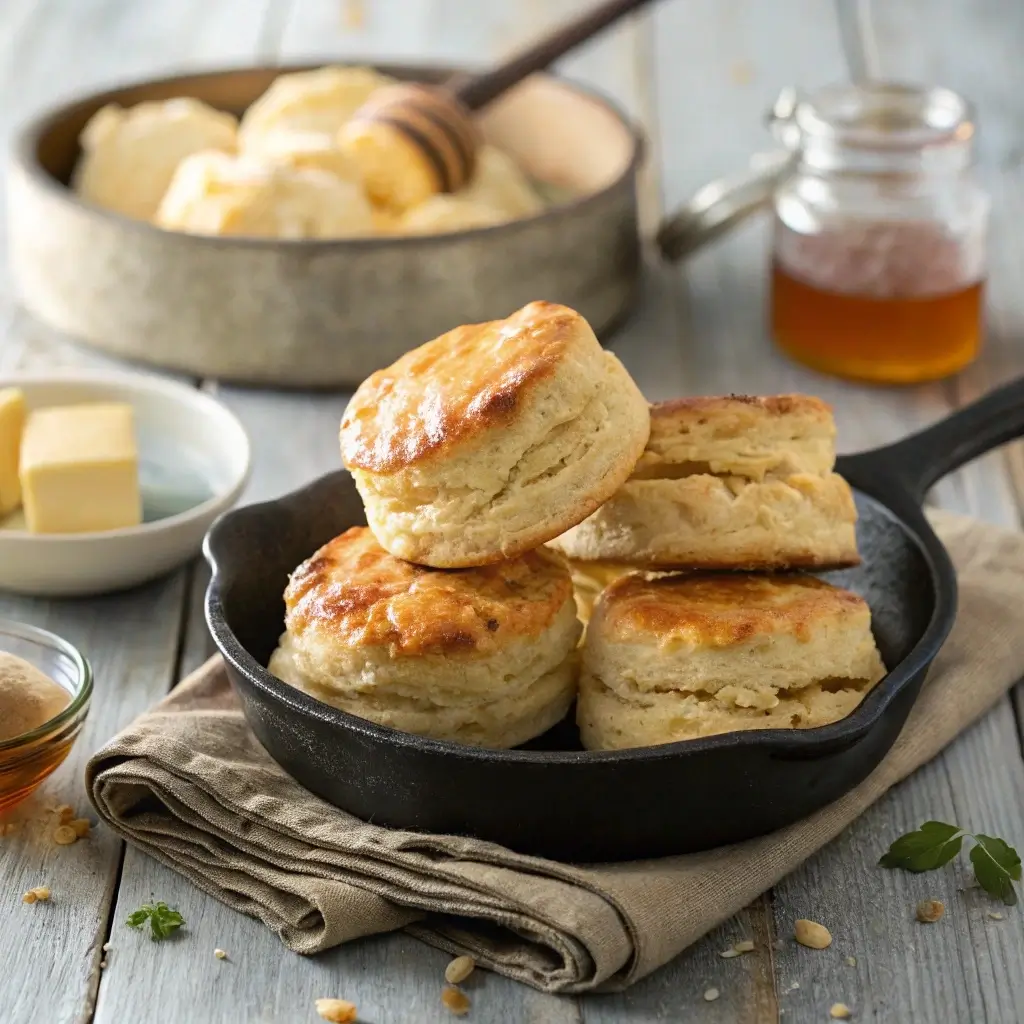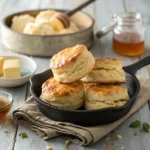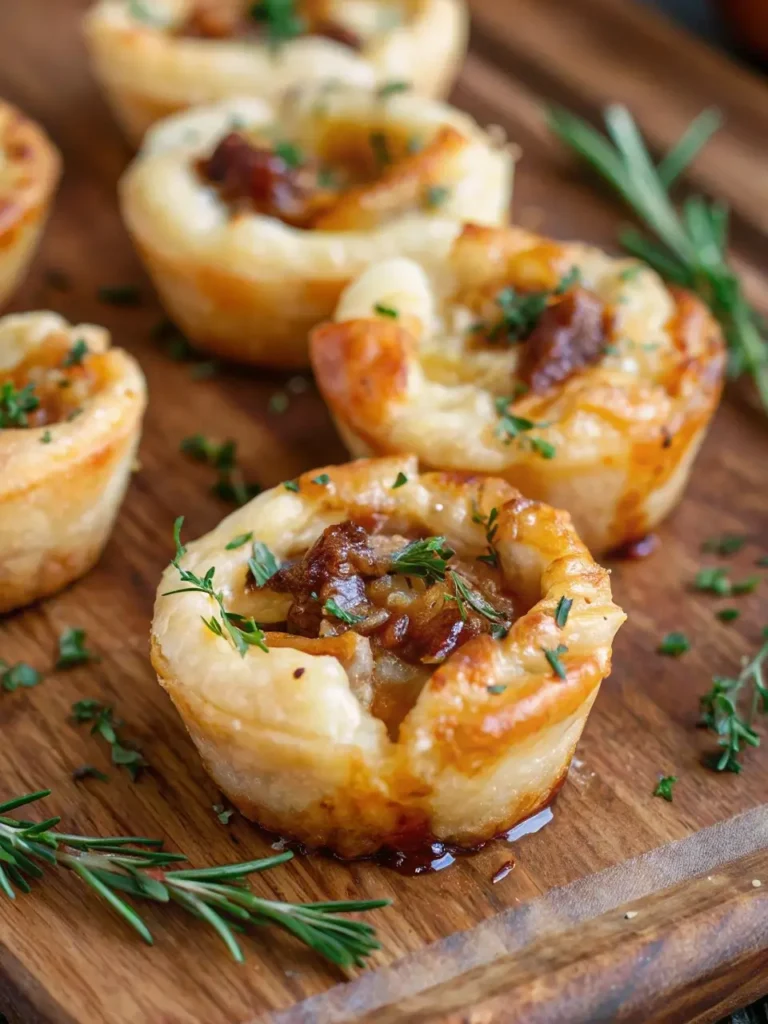Few things beat the smell of warm, buttery biscuits fresh out of a hot skillet. Skillet buttermilk butter biscuits bring together all the best parts of comfort food—crispy golden edges, tender flaky layers, and a rich, buttery bite that melts in your mouth. Whether you’re making them for breakfast, dinner, or a snack straight from the pan, this Southern classic is easy to master with just a few ingredients and one cast iron skillet.
In this guide, you’ll learn the secrets to making the perfect skillet buttermilk butter biscuits at home. From choosing the right ingredients to troubleshooting crumbly dough, we’ll walk you through it step-by-step—plus answer the most common biscuit questions along the way. If you’re planning a full brunch spread, these biscuits pair beautifully with eggs—discover great ideas like our Cheese Omelette Recipe for a cheesy, satisfying match.
PART 1: Why Skillet Buttermilk Butter Biscuits Are a Southern Classic
The Tradition of Biscuit Baking in Cast Iron
In many Southern homes, the cast iron skillet isn’t just a tool—it’s a tradition. And when it comes to biscuits, it makes a difference. Skillet buttermilk butter biscuits are known for their deeply golden bottoms, perfectly puffed layers, and tender centers. That’s thanks to the even heat and retained moisture that cast iron provides during baking.
Instead of dry, flat biscuits on a baking sheet, the skillet gives you biscuits with:
- Crisp, buttery edges
- Soft, pillowy interiors
- A golden crust that’s hard to beat
This method has been passed down through generations, especially in Southern kitchens where biscuits are more than food—they’re a ritual. It’s the kind of recipe that turns a simple dinner into a warm, memory-making experience.
What Sets Skillet Biscuits Apart from the Rest
So what makes skillet buttermilk butter biscuits different from other biscuits?
- The skillet preheats in the oven, so when the dough hits the pan, it starts crisping immediately
- The butter in the dough melts fast, creating steam and rise
- They’re baked close together, encouraging a soft rise and fluffy sides
- The cast iron retains heat better than a baking sheet, helping biscuits cook evenly and rise tall
It’s this combo of buttermilk tang, butter richness, and cast iron crisp that makes skillet biscuits so special.
PART 2: Choosing the Right Ingredients for Perfect Buttermilk Biscuits
Every biscuit begins with a simple formula: flour + fat + liquid. But when you’re making skillet buttermilk butter biscuits, the type, temperature, and ratio of those ingredients determine whether you’ll end up with fluffy layers or flat, dense disappointments.
Let’s break down what makes each element work—and how to build biscuit success from the ground up.
Cold Butter Is Non-Negotiable
If you want tall, flaky skillet buttermilk butter biscuits with golden, crisp edges and tender centers, you absolutely need cold, cubed butter.
Why? Because when cold butter hits a hot skillet, it melts instantly, releasing steam that helps lift the dough and create beautiful layers. Soft or melted butter won’t cut it—it blends into the flour instead of forming pockets, leaving you with heavy, flat biscuits.
🧈 Best butter for skillet biscuits:
- Unsalted butter – lets you control salt levels
- High-fat European-style butter – adds extra richness
- Frozen butter cubes – shred or chill for 5–10 minutes before mixing
Cold butter = flaky biscuits. Always.
Real Buttermilk Brings Tang and Rise
Real buttermilk isn’t just a liquid filler—it’s a biscuit game-changer. The acidity in buttermilk reacts with baking soda to create lift, while also adding that unmistakable Southern tang that makes skillet buttermilk butter biscuits stand out.
🥛 No buttermilk at home? Try this substitute:
- Mix 1 cup whole milk with 1 tbsp lemon juice or vinegar
- Let sit for 5–10 minutes until curdled
- Works in a pinch, but nothing beats the flavor and lift of real buttermilk
Pro Tip: Keep your buttermilk cold and handle the dough gently. Overmixing is one of the top reasons why homemade buttermilk biscuits turn out tough.
Flour, Leavening & Salt: The Dry Backbone
Your dry mix is the structure behind every biscuit. For light, fluffy skillet buttermilk butter biscuits, don’t skip or swap the basics:
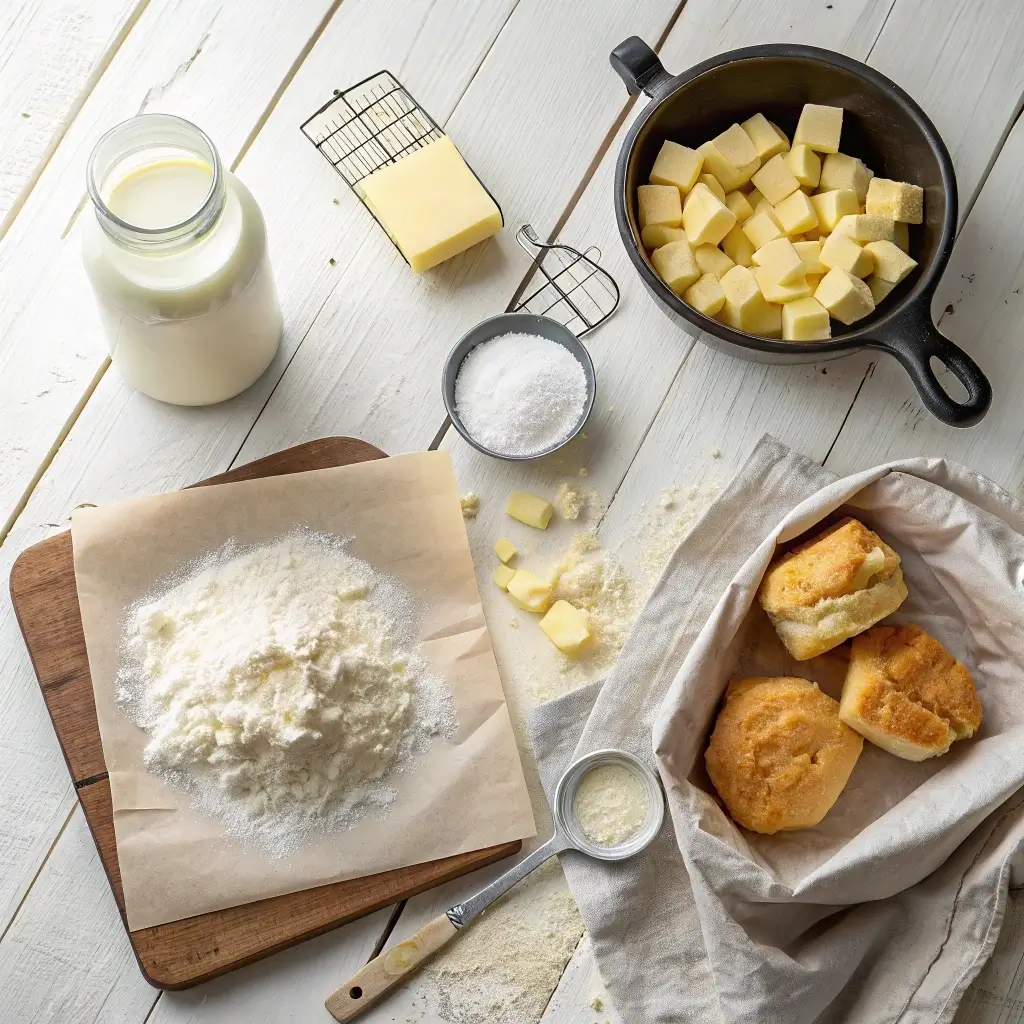
| Ingredient | Why It Matters |
|---|---|
| All-purpose flour | Balanced texture—soft but holds its shape |
| Baking powder + soda | Provides rise and reacts with buttermilk |
| Salt | Enhances flavor and balances the richness |
Always use fresh baking powder—anything older than 6 months might not give your biscuits that high, fluffy rise you’re after.
Want to use up leftover buttermilk or make it a full breakfast spread?
Discover great ideas like our Peanut Butter Coffee Cake Recipe—moist, buttery, and the perfect sweet companion to your skillet biscuits.
PART 3: Step-by-Step Skillet Buttermilk Butter Biscuit Recipe
Making the perfect biscuit isn’t about fancy ingredients—it’s about the right technique. When done right, skillet buttermilk butter biscuits rise tall, stay soft inside, and develop a buttery, golden-brown crust you can’t resist.
Whether it’s your first time baking biscuits or you’re aiming to perfect your Southern-style recipe, this method guarantees flaky, flavorful results every time.
📝 Ingredients (Makes 8–10 biscuits)
- 2 cups all-purpose flour
- 1 tbsp baking powder
- ½ tsp baking soda
- ¾ tsp salt
- ½ cup (1 stick) cold unsalted butter, cubed
- ¾–1 cup cold buttermilk
- 1 tbsp melted butter (for brushing)
- 1 tbsp butter or oil (for greasing skillet)
👨🍳 Instructions for Flaky, Golden Skillet Buttermilk Butter Biscuits
- Preheat your oven to 425°F (218°C) and place your cast iron skillet inside while it heats. This helps the biscuits form crispy, buttery bottoms the second they hit the pan.
- Mix the dry ingredients: In a large bowl, whisk together flour, baking powder, baking soda, and salt.
- Cut in the butter: Add cold, cubed butter to the flour mixture. Use a pastry cutter or your fingers to break it down into pea-sized crumbs. This creates flaky pockets inside your skillet buttermilk butter biscuits.
- Add the buttermilk: Pour in ¾ cup cold buttermilk and mix gently with a fork or spatula. Add more, 1 tbsp at a time, if the dough feels dry. Be careful not to overmix.
- Fold and flatten: Transfer the dough to a floured surface. Gently press into a 1-inch thick rectangle, then fold in half. Repeat this folding step three times to build buttery layers that puff up in the oven.
- Cut the biscuits: Use a biscuit cutter or floured glass to cut out 2.5–3 inch rounds. Press straight down—don’t twist—to preserve the rise.
- Grease the hot skillet: Remove it from the oven carefully. Add 1 tbsp butter or oil, and tilt the pan so the bottom is fully coated.
- Place the biscuits in the skillet: Arrange them close together so they touch slightly—this helps them rise taller and stay tender on the sides.
- Bake for 15–18 minutes or until the tops are golden and the bottoms crisp.
- Brush with melted butter immediately after baking for a rich, glossy finish.
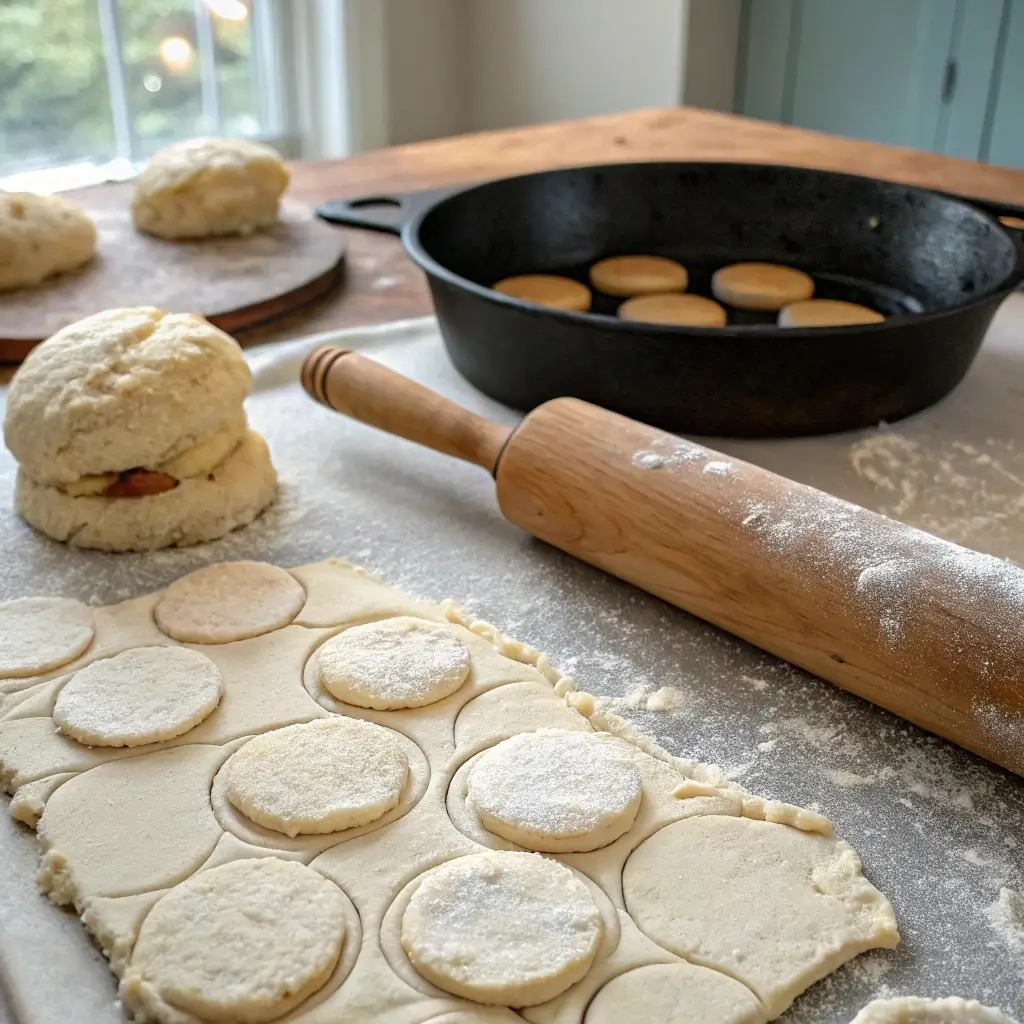
🔥 Tips for Success with Skillet Buttermilk Butter Biscuits
- Don’t overwork the dough—mix just until combined
- Keep all ingredients cold for a light, flaky texture
- Always preheat your skillet for that signature crisp base
- Folding the dough adds structure and layers—don’t skip it!
Once you’ve nailed these steps, skillet buttermilk butter biscuits will become your favorite go-to recipe for breakfasts, brunches, or cozy Southern dinners.
Looking for a rustic dessert to serve afterward?
Try our Cottage Cheese Chocolate Pudding—it’s rich, smooth, and protein-packed, making it the perfect ending to a hearty biscuit meal.
PART 4: Why Cast Iron Skillets Make the Best Biscuits
If you’ve only ever baked biscuits on a sheet pan, you’re missing out. When it comes to skillet buttermilk butter biscuits—with crispy, golden bottoms and soft, flaky centers—cast iron skillets are in a league of their own.
Here’s why Southern cooks (and biscuit lovers everywhere) swear by them.
🔥 Even Heat = Perfect Rise and Browning
Cast iron skillets distribute heat evenly and steadily, which is exactly what skillet buttermilk butter biscuits need to:
- Rise tall without burning
- Bake consistently from edge to center
- Develop a buttery, golden crust that sheet pans can’t match
When you preheat the skillet before placing your biscuit dough inside, the base of each biscuit begins cooking right away—giving you that classic skillet-crisp bottom with a tender, steamy middle.
🧈 Retains Heat Like a Champ
Unlike aluminum or nonstick bakeware, cast iron holds onto heat long after it leaves the oven. That means your biscuits:
- Continue baking gently for a minute or two after removal
- Stay warm on the table, even without reheating
- Maintain their texture without drying out or getting rubbery
It’s no surprise why skillet buttermilk butter biscuits are a brunch and holiday favorite—they look and taste best served straight from the pan.
🧽 Naturally Nonstick & Seasoned for Flavor
With time and use, your cast iron skillet develops a natural seasoned surface—a nonstick coating that:
- Prevents sticking without any spray or liners
- Adds depth of flavor over time
- Makes cleanup super simple—just wipe clean with a dry cloth or paper towel
Bonus Tip: Even if your skillet is seasoned, always grease it with a bit of butter or oil before placing in the biscuits. It adds extra flavor, helps brown the bottoms beautifully, and ensures a crisp release after baking.
Want another skillet-friendly recipe that brings bold flavor to your table?
Check out our Baked Feta Recipe—it’s savory, cheesy, and proves that your cast iron skillet is more than just a biscuit pan.
PART 5: Troubleshooting Common Biscuit Problems
Even the most experienced home bakers run into biscuit problems from time to time. The good news? Most issues with skillet buttermilk butter biscuits come down to just a few simple fixes—and knowing what to look for can make a huge difference in your results.
If your biscuits aren’t rising, feel dry, or fall apart when picked up, don’t worry. Let’s troubleshoot the most common problems and get you back to buttery, flaky perfection.
❌ Problem: Biscuits Fall Apart After Baking
When your skillet buttermilk butter biscuits are crumbly and dry, it’s often a result of:
- Too little fat in the dough
- Overbaking, which pulls moisture from the biscuit
- Not brushing with butter post-bake (which helps soften crust)
✅ Fix:
- Stick to the correct ratio: ½ cup butter for every 2 cups flour
- Don’t bake too long—check at 14–15 minutes
- Brush with melted butter right after baking to keep them tender and flavorful
❌ Problem: Biscuits Didn’t Rise
Flat, dense biscuits are often caused by:
- Expired baking powder or soda
- Overmixed dough, which tightens the gluten
- Twisting the biscuit cutter, which seals the edges and limits rise
✅ Fix:
- Replace your baking powder every 3–6 months
- Mix gently—stop as soon as the dough comes together
- Always press straight down with your cutter—no twisting
❌ Problem: Undercooked or Gummy Centers
If your biscuits look done but feel wet inside, it could be from:
- Too much buttermilk
- Dough rolled too thick
- Oven not fully preheated
- Overcrowding in the skillet
✅ Fix:
- Make sure your oven is fully preheated to 425°F before baking
- Roll dough to a consistent ¾ to 1 inch thickness
- Avoid stacking or overlapping biscuits in the skillet—let them just touch
🧠 Quick Reference: Biscuit Mistake Fixes
| Mistake | Fix |
|---|---|
| Overmixed dough | Stop mixing as soon as dough forms |
| Cold oven | Always preheat—especially when using cast iron |
| Warm butter | Chill or freeze before mixing into dry ingredients |
| Twisted cutter | Press straight down—don’t twist! |
By keeping these tips in mind, your next batch of skillet buttermilk butter biscuits will rise higher, stay flakier, and taste better than ever.
Looking for the perfect sweet pairing to go with your warm, buttery biscuits?
Discover great ideas like our Peanut Butter Coffee Cake Recipe—a moist, soft breakfast cake that brings balance to your savory biscuit spread.
PART 6: FAQs About Skillet Buttermilk Butter Biscuits
Whether you’re new to biscuit baking or fine-tuning your technique, these are the most commonly asked questions about making, storing, and perfecting skillet buttermilk butter biscuits.
Do leftover buttermilk biscuits need to be refrigerated?
It depends on how long you’re planning to keep them:
- Up to 2 days: Store in an airtight container at room temperature.
- More than 2 days: Refrigerate to keep them from drying out.
To reheat: Wrap in foil and warm in a 300°F oven for 5–7 minutes to revive that soft, buttery texture. This works great for skillet buttermilk butter biscuits, especially when you want to keep the crisp bottoms intact.
Are biscuits better in a cast iron skillet?
Yes—absolutely. Cast iron skillets:
- Distribute heat evenly
- Create a crisp, golden crust on the bottom
- Retain heat better than baking sheets
That’s why skillet buttermilk butter biscuits have become a Southern favorite. The cast iron locks in heat and gives each biscuit a rustic, bakery-style finish.
How do you know when buttermilk biscuits are done?
Biscuits are ready when:
- Tops are golden brown
- Edges feel firm to the touch
- A toothpick inserted in the center comes out clean
- Bottoms are crisp and lightly browned, thanks to the preheated skillet
Bake time for most skillet buttermilk butter biscuits is 15–18 minutes at 425°F.
Why do my buttermilk biscuits fall apart?
Common causes include:
- Not enough fat in the dough
- Overbaking, which removes moisture
- Overworking the dough or cutting the butter too small
✅ Fix:
Use cold, cubed butter, real buttermilk, and mix gently until the dough just comes together.
What is the secret to a good biscuit?
The best skillet buttermilk butter biscuits are made with:
- Cold ingredients (especially butter and buttermilk)
- Minimal mixing for tender texture
- A preheated skillet to crisp the bottom
- Tight placement—when biscuits touch in the pan, they help each other rise
Follow these and you’ll consistently get biscuits that are fluffy, flaky, and full of buttery goodness.
How do you keep buttermilk from separating?
Buttermilk naturally separates, but it’s still safe to use if:
- It smells fresh—slightly tangy, not sour
- You shake or stir it well before pouring
- It’s still within the expiration date
💡 For long-term storage, freeze buttermilk in small portions using an ice cube tray or airtight container. Thaw as needed for your next batch of skillet buttermilk butter biscuits.
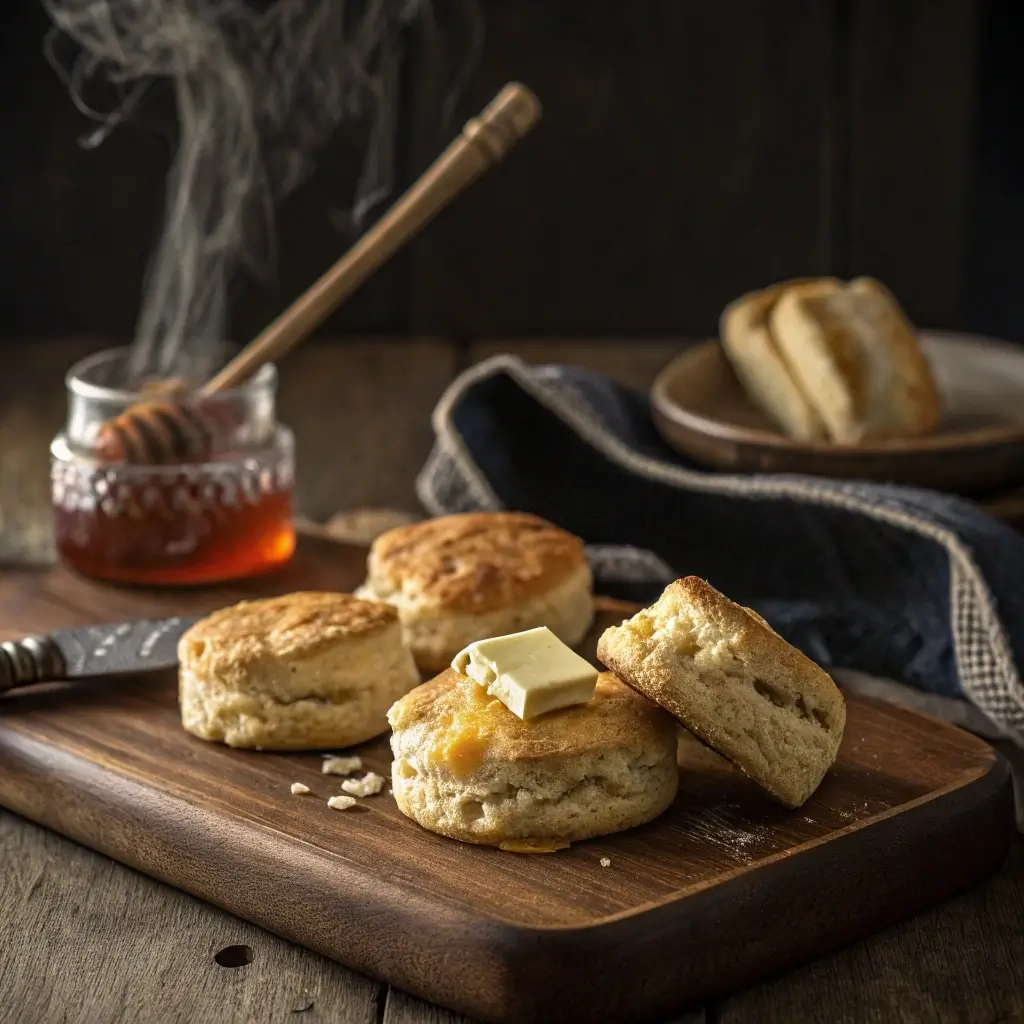
PART 7: Conclusion – Your New Go-To Biscuit Recipe
There’s something deeply satisfying about pulling a hot skillet full of golden, buttery biscuits out of the oven. From the crispy bottoms to the flaky, tender centers, skillet buttermilk butter biscuits offer everything you love about homemade comfort food—without the stress or fuss.
With just a few simple ingredients and the right techniques—like keeping your butter cold, using real buttermilk, and baking in a hot cast iron skillet—you can make biscuits that rival any bakery or Southern diner. Whether you’re serving them with gravy, jam, honey, or alongside eggs and bacon, these biscuits are as versatile as they are irresistible.
Plus, now that you’ve learned how to fix common biscuit problems and answered those lingering FAQs, you’ve got everything you need to bake with confidence.
So go ahead—preheat that skillet, cut in some cold butter, and enjoy the timeless joy of warm biscuits from scratch.
Looking for the perfect side dish or dessert to pair with your biscuits?
👉 Don’t miss our Cottage Cheese Chocolate Pudding—a rich, creamy dessert that balances out any savory breakfast or brunch plate.
👉 Want even more cozy Southern recipes, breakfast inspiration, and baking ideas?
Follow us on Pinterest for new ideas every week:
🔗 https://www.pinterest.com/RecipesFaza/
Skillet Buttermilk Butter Biscuits
Golden, fluffy, and crisp-bottomed—these skillet buttermilk butter biscuits are a Southern staple made in one hot pan. Perfect with jam, gravy, or honey.
- Prep Time: 10 minutes
- Cook Time: 18 minutes
- Total Time: 28 minutes
- Yield: 8–10 bisc 1x
- Category: Bread, Breakfast
- Method: Baked, Skillet
- Cuisine: Southern
- Diet: Vegetarian
Ingredients
2 cups all-purpose flour
1 tbsp baking powder
½ tsp baking soda
¾ tsp salt
½ cup unsalted butter, cubed and cold
¾–1 cup cold buttermilk
1 tbsp melted butter (for brushing)
1 tbsp butter or oil (for greasing skillet)
Instructions
Preheat oven to 425°F and place your skillet inside.
Mix flour, baking powder, soda, and salt.
Cut in butter until mixture resembles coarse crumbs.
Stir in cold buttermilk until dough comes together.
Fold dough 3 times, roll to 1 inch thick, and cut into rounds.
Carefully remove skillet, grease, and place biscuits touching.
Bake 15–18 minutes. Brush tops with melted butter.
Serve warm with butter, honey, or gravy.
Notes
Don’t twist the cutter—press straight down.
Freeze cubed butter before cutting in for max flake.
Use real buttermilk for best results (not milk + vinegar).
Nutrition
- Serving Size: 1 biscuit
- Calories: 190
- Sugar: 1g
- Sodium: 340mg
- Fat: 10g
- Saturated Fat: 6g
- Unsaturated Fat: 3g
- Trans Fat: 0g
- Carbohydrates: 22g
- Fiber: 1g
- Protein: 3g
- Cholesterol: 25mg
Keywords: skillet buttermilk butter biscuits, cast iron biscuits, Southern biscuits

